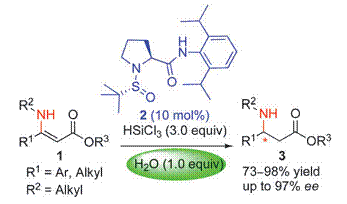In recent years, the research group of Prof. Jian Sun from the Natural Products Center of Chengdu Institute of Biology, Chinese Academy of Sciences has conducted systematic and in-depth research in the field of chiral Lewis base catalytic asymmetric reduction, and has achieved a series of original research results. Their latest research found that using the designed new Lewis base catalyst, the high enantioselective reduction of a series of N-alkyl β-dehydroamino acid esters with trichlorosilane can be achieved for the first time, with a yield of up to 98% The rate and 97% enantioselectivity achieved a new breakthrough in this research field. In particular, their research found that the addition of water is crucial to the high yield and high enantioselectivity of the reaction system, and water is generally considered to be destructive to this type of reaction system. The research results have been published in Chem. Eur. J. (2011, 17, 2846–2848). OSFE INDUSTRIAL CO.,LTD , http://www.1758cookware.com
Chiral β-amino acids are important building blocks for the construction of various drugs, natural products and biologically active molecules. For example, β is present in the molecular structure of the hypoglycemic agent Emeriamine, the cancer treatment drug paclitaxel, antibiotic ADDA, broad-spectrum antibiotic amoxicillin -Amino acid structural unit. Asymmetric reduction of β-dehydroamino acid esters is one of the most direct and effective methods for synthesis of chiral β-amino acids. In recent years, great progress has been made in the asymmetric reduction of β-dehydroamino acid esters catalyzed by chiral catalysts, especially in the reduction of N-acyl β-dehydroamino acid esters. Excellent results; recently, there have also been reports that the use of chiral small molecule catalysts can achieve high enantioselective reduction of N-aryl β-dehydroamino acid esters. But so far, there is no method to achieve high enantioselective reduction of N-alkyl β-dehydroamino acid esters.
New breakthrough in the asymmetric reduction of β-dehydroamino acid esters in Chengdu Institute of Biology